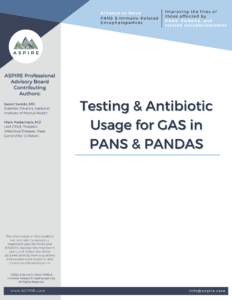Toolkit – Testing & Antibiotic Usage for GAS in PANS & PANDAS
ASPIRE’S Professional Advisory Board publishes Testing & Antibiotic Usage for GAS in PANS & PANDAS
The section below provides only a brief overview of the Professional Advisory Board Toolkit on the Testing & Antibiotic Usage for GAS in PANS & PANDAS. Please download the Toolkit for the complete information.
Important to note:
- A negative GAS test (rapid, culture, or blood work) DOES NOT rule out PANDAS or PANS
- PANDAS symptoms can start even after a GAS infection has been treated
- Some patients do not produce ASO or ADB titers
- Even without past bloodwork showing a previous GAS infection, one can still have PANDAS
- GAS infection was the inciting infection of PANS in as many as 40%–77% of cases
Download Toolkit:
Testing & Antibiotic Usage for GAS in PANS PANDAS toolkit
Testing and Treating GAS in PANS & PANDAS
A temporal relationship between GAS and the onset of symptoms associated with PANDAS must be established to make a firm PANDAS diagnosis. GAS is the most often recognized PANS trigger, but Mycoplasma pneumoniae, influenza, other common viruses, and non-infectious triggers have been noted. Non-infectious triggers include metabolic and neurologic changes and psychosocial stress. Sometimes, there is no clear trigger. Since there are various non-GAS triggers, nonspecific immune activation mechanisms may contribute to symptom development. PANS and PANDAS are clinically diagnosed. The following section provides a brief overview of establishing a temporal relationship between the onset of PANDAS symptoms and GAS.
When to Test for GAS with PANS & PANDAS
- At initial PANS evaluation – perform a GAS throat swab in all cases, even if there are no clinical symptoms of streptococcal pharyngitis, regardless of the PANS symptom severity
- During flares & during signs of strep throat – throat swabs are needed, especially if the patient is not on an appropriate antibiotic
- Perianal and other sites – observe and culture when an infection is suspected. An erythematous perianal halo is often seen in children with perianal streptococcal infection.
- Close contacts – swab at the time of initial diagnosis and during exacerbations if there are signs of GAS infection and treat if positive
Treating GAS in PANS & PANDAS
Antibiotic usage for acute GAS infection aims to eliminate GAS infection to minimize nonsuppurative sequelae, such as rheumatic fever and PANDAS, and prevent reinfections and PANDAS exacerbations. Guidelines developed for the prevention of rheumatic fever should guide GAS prevention with prophylactic antibiotics. Even though prophylactic antibiotic use for GAS in PANDAS is not supported by sufficient evidence, the PRC will often prescribe long-term antimicrobial prophylaxis for severely affected patients and those with multiple PANDAS flares. Antimicrobial prophylaxis may be beneficial in preventing neural injury caused by future GAS-associated exacerbations in patients with clear PANDAS.
- All newly diagnosed PANS cases should be prescribed an initial course of anti-streptococcal treatment even if no GAS is identified at the time of diagnosis.
- This is similar to the recommended management of rheumatic fever.
- Some PRC investigators provide this initial antibiotic treatment for 3-4 weeks, awaiting the resolution of neuropsychiatric symptoms.
- Patients who fully meet the criteria of PANDAS and present with severe neuropsychiatric symptoms or recurrent GAS-associated exacerbations should be prescribed chronic secondary antimicrobial prophylaxis.
- PANS patients with non-streptococcal triggers should be monitored for streptococcal pharyngitis or dermatitis as well as in their close contacts.
- All patients with PANS or PANDAS should be closely monitored for other intercurrent infections, including sinusitis and influenza, and possible adverse reactions to conventional immunizations that should promptly be treated as per standard guidelines.
Management of Non-GAS PANS
The onset and exacerbations of PANS associated with nonstreptococcal infections should be diagnosed and treated as per standard clinical practice. Many infections, including herpes simplex, varicella, gastrointestinal infections, dental infection, Epstein-Barr virus, enterovirus, and others, and Kawasaki disease and anaphylactoid purpura, have been associated with the onset or exacerbation of PANS symptoms. It is important to note that onset and exacerbations of PANS symptoms may happen in the absence of an identifiable infection, suggesting that additional disease mechanisms may be involved. Thus, it seems likely that many possible infectious triggers may activate symptoms through nonspecific immune activation mechanisms.
As described earlier, at the time of diagnosis, even without evidence that GAS triggered symptoms, the PRC recommends treating for GAS with antibiotics as done in rheumatic fever since testing can be inaccurate. If there is no clear link to GAS infection, long-term antimicrobial prophylaxis is not currently recommended. However, if a trial of a cephalosporin agent or amoxicillin/clavulanate is not effective at improving clinical status, a trial of azithromycin should be considered. Close monitoring and treatment of infections in close contacts are advised. If the patient begins to have repeated GAS-incited flares, their diagnosis should change from nonstreptococcal PANS to PANDAS.
 To Download: Click the button below to download the 12-page toolkit.
To Download: Click the button below to download the 12-page toolkit.
Testing & Antibiotic Usage for GAS in PANS PANDAS toolkit
To Email or Share this Page Via Social Media: Copy and paste the link or use one of the buttons on the side (desktop) or bottom (mobile) of each page of the website.
ASPIRE Professional Advisory Board Contributing Authors:
-
Susan Swedo, MD – Scientist Emerita, National Institute of Mental Health
-
Mark Pasternack, MD – Unit Chief, Pediatric Infectious Disease, Mass General for Children
Click for more information about the ASPIRE Professional Advisory Board
Return to Section:
